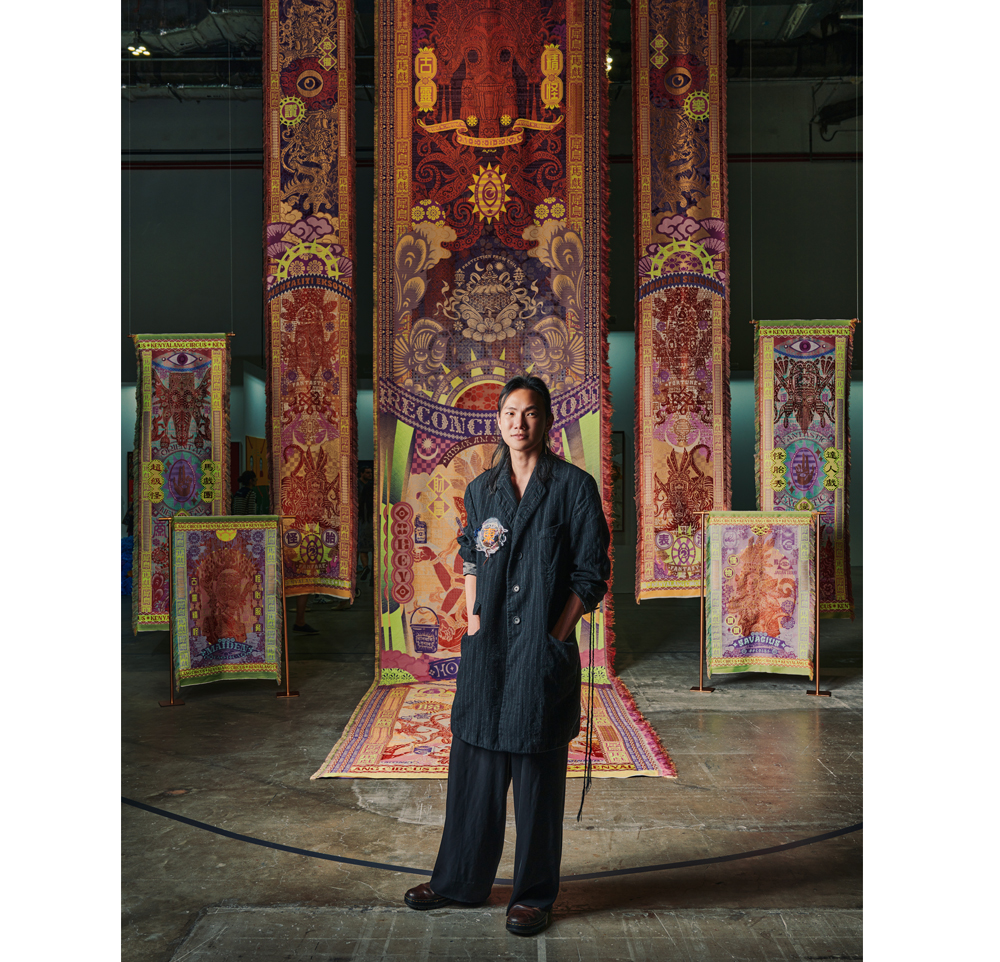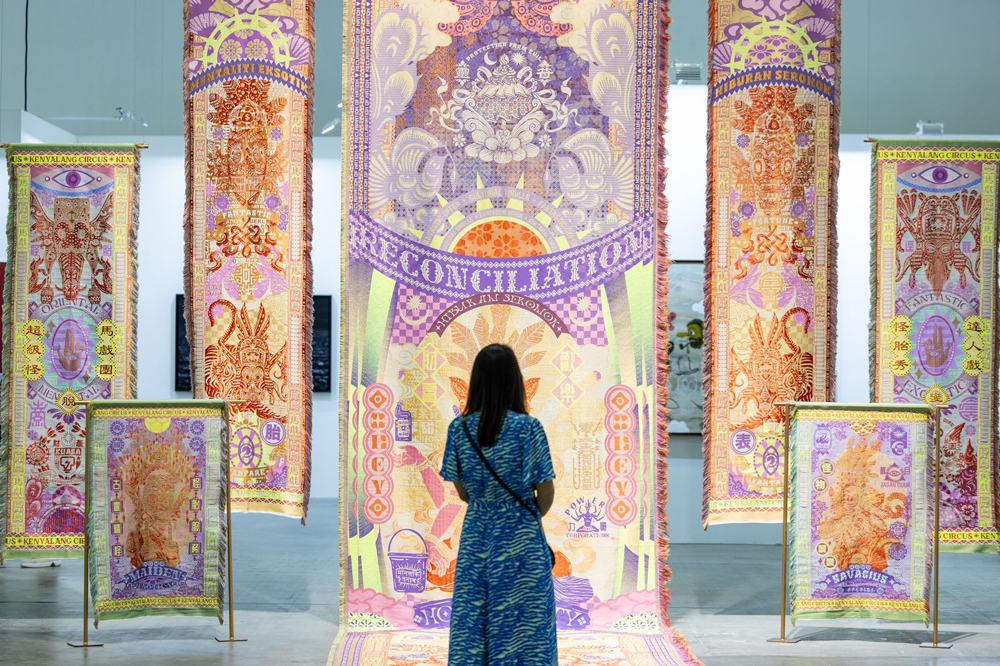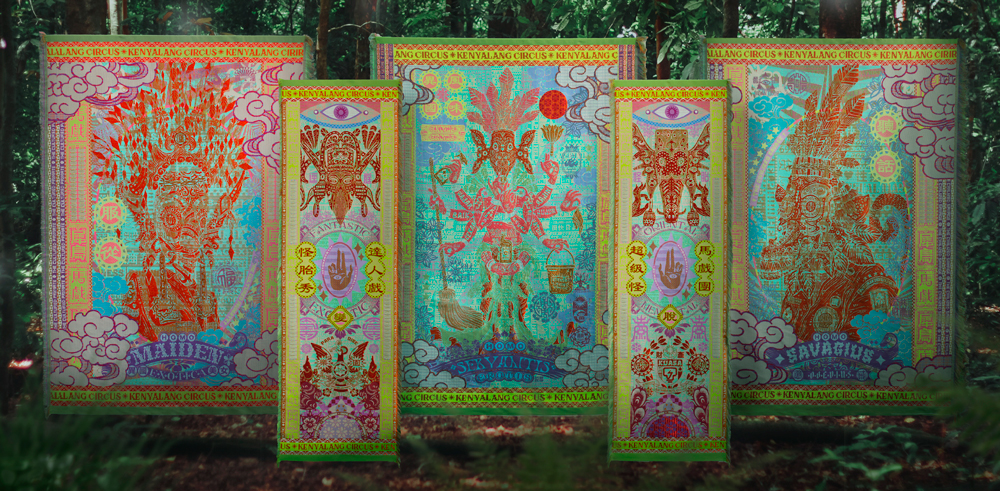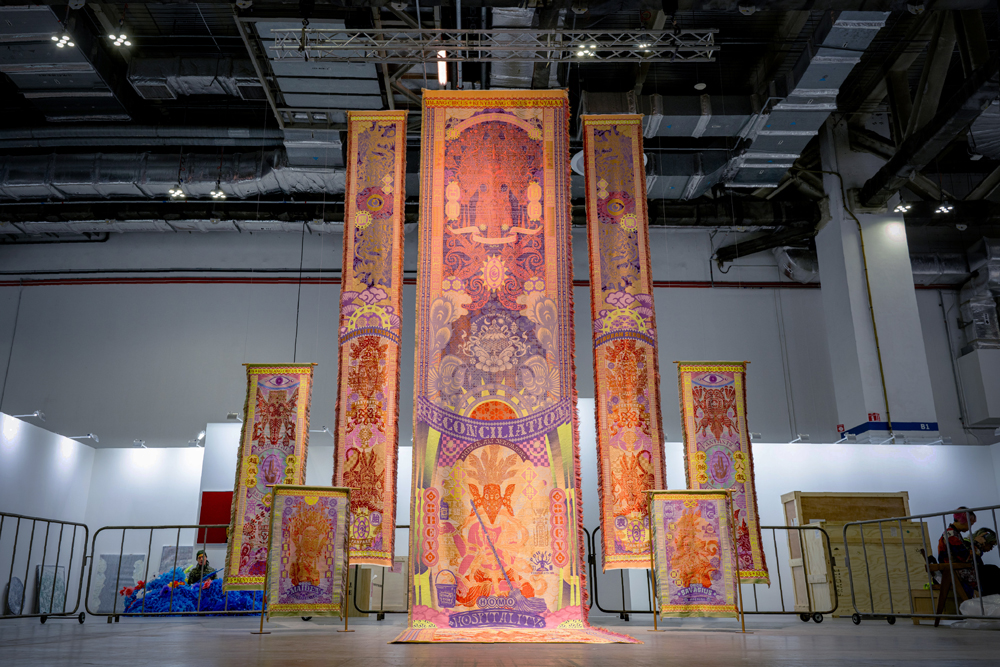Meet the nominees for the NN Art Award 2025: Marcos Kueh
For the ninth consecutive year, the NN Art Award will be presented in 2025 to a promising artist showcasing their work at Art Rotterdam. This year’s nominees are Diana Scherer (andriesse eyck galerie), Marcos Kueh (Prospects section of the Mondriaan Fund, courtesy of Galerie Ron Mandos), Pris Roos (Mini Galerie) and Bodil Ouédraogo (Prospects section of the Mondriaan Fund). The work of the four nominees will be on view at Kunsthal Rotterdam from 15 March until 11 May 2025.

Marcos Kueh (1995) explores the intersections of heritage, identity and contemporary visual culture through his textile-based practice. His woven installations serve as vessels for storytelling, blending traditional craftsmanship with contemporary themes and techniques. At the heart of his work lies an inquiry into the role of textiles as a medium for historiography and self-reflection.
Kueh grew up in postcolonial Malaysia, in the Malaysian part of Borneo, where the legacy of colonial influence, exoticisation and cultural displacement remains deeply embedded. This layered history is central to his artistic practice. Initially, Kueh studied graphic design and advertising at the Royal Academy of Art in The Hague, but it was only when he began exploring textile design at the same institution that he recognised the potential of textiles as a form of expression. He became fascinated by how his ancestors in Borneo wove stories, myths, and dreams into intricate patterns. This discovery led him to merge traditional weaving techniques from Borneo and other Southeast Asian regions with contemporary Western industrial methods, forging a dialogue between past and present. Beyond its narrative potential, Kueh is also deeply invested in the technical precision and craftsmanship inherent to textile-making.

His work engages with self-awareness and the complexities of decolonisation: both as a historical process and in the ways it continues to shape personal and collective identities. While studying in the Netherlands, he first encountered academic discourses on decolonisation. This experience gave language to a longstanding sense of injustice he had struggled with, revealing it to be not only personal but also systemic. Kueh juxtaposes constructed representations with his own lived experience, interrogating the persistent colonial and postcolonial narratives that continue to shape identity in Southeast Asia. He raises critical questions about terms like ‘Third World country’ and examines who holds the power to narrate the histories of formerly colonised nations. He points out that in Western academic contexts, decolonisation is often framed as a theoretical concept, while the voices from formerly colonised regions — those who originally led decolonisation movements — remain underrepresented. Through his textile works, Kueh confronts these dynamics. His practice bridges personal lived experience with academic reflection, examining how we shape and understand our own histories. He observes that Malaysians often neglect their own stories and history, while unconsciously internalising the colonial gaze that was once imposed upon them.
At Art Rotterdam, Kueh (courtesy of Galerie Ron Mandos) will present a work in the Prospects section of the Mondriaan Fund, delving deeper into the layered nature of identity and cultural heritage. Originally developed for Manifesta 15, this installation was previously exhibited in a 17th-century church in Barcelona, where it engaged in dialogue with a Christian altarpiece — an emblem of the religion introduced to Malaysia by European colonial powers under the guise of ‘civilisation’. In this work, Kueh visualises the inner tension of a postcolonial identity: the struggle between assimilation and authenticity, between adaptation and resistance. In doing so, he dismantles the colonial legacy of Catholicism in Borneo in a way.
Beyond the historical and political dimensions of his work, Kueh also examines how mass communication and advertising shape cultural representation. He draws parallels between traditional storytelling systems and contemporary marketing strategies, exploring how visual communication can manipulate or instrumentalise cultural identity. His woven billboards construct a fictional world where textiles function as a form of visual propaganda, commenting on the ways in which identity is consumed, redefined, and eroded within the capitalist system.
Kueh invites the viewer to look beyond the aesthetic qualities of textiles and instead engage with the deeper structures of history, identity, and craftsmanship embedded within them. At the same time, he infuses his work with humour and satire, perhaps to make the medicine go down easier or to start more meaningful conversations. By interweaving contemporary myths and legends with Sarawakian motifs, symbols, and figures, he creates an alternative mode of visual storytelling.

Marcos, could you tell us a bit more about the work you’re presenting at Art Rotterdam and in the Kunsthal?
Kenyalang Circus is a long term project I started in 2016, that speaks about the exotification of my identity as a person from Borneo. From anthropological museums to tourism advertisements, how we are being described becomes how we describe ourselves, becomes how we perform to the people who wrote our descriptions. The giant woven posters and billboards in these series usually depict images of creatures manifested from stereotypical ideas of the mysterious unknown of the Borneo rainforests. My job, as the ringmaster of the circus, is to parade them around and try to “sell my exotic identity”. The circus has travelled all over the world in many iterations and this will be our debut in Rotterdam.
The work “Homo Reconciliation Eternatus”, originally commissioned for the 15th Manifesta Biennale in Spain, will be performing at the Prospects section of Art Rotterdam. It speaks about the internal struggle to love ourselves and find pride as people from developing countries. “Nenek Moyang”, which debuted in ART Singapore, will be showcased in Kunsthal Rotterdam. The 8 meter woven billboard is displayed like a waterfall – a nod to the Bornean myth in which the ancestors who live in heaven would only travel to the earthly realms through the waterfalls. The high display also prompts viewers to practise looking upwards to your own culture.

What are your plans for 2025?
In 2025, I will be attending a few residencies for the first time as a professional artist. Many of the project plans have been naturally progressing into conversations about factory work. As a Chinese-passing [a person often perceived as Chinese based on their appearance, ed.] non-European person who is deeply involved in the Dutch textile industries, I am excited to dive into stories and conversations about class, capitalism, migration and identity on the factory line. My work has always been about textiles as a finished product, so it is interesting to expand my exploration into the systems surrounding this production. Hopefully by this time next year, I will have many meaningful stories to share.
Can you describe how you felt when you heard you were nominated for the NN Art Award?
I was in Malaysia when I received the news and immediately went to grab some food with my family to celebrate. I’m just glad that there are people out there who consider my work valuable and am glad that by chance, my family was close by to share in the joy.
If you were to win the award, which project would you immediately pursue?
The award will definitely open up new possibilities on my upcoming research projects into factory work and allow me to consider more locations to visit, plus more people to talk to. In a way, the award has already given me so much spotlight, I am also hoping to bring that light forward to undiscovered stories, conversations and perspectives of labourers who we normally can’t interact with in our day to day lives.
At Art Rotterdam, Kueh’s work will be on view in the 13th edition of Prospects, an initiative by the Mondriaan Fund. This exhibition presents work by 116 artists who received financial support in 2023 to aid them in the start of their careers. The section is curated by Johan Gustavsson and Louise Bjeldbak Henriksen. Explore all Prospects artists here.

Marcos Kueh was born in 1995 in Sarawak and divides his time between the Netherlands and Malaysia. In recent years, his work has been exhibited at the Stedelijk Museum, Kunstinstituut Melly, Manifesta, The Backroom in Kuala Lumpur, and Museum Voorlinden. In 2022, he was awarded the Ron Mandos Young Blood Award, after which Museum Voorlinden acquired one of his works. Joop van Caldenborgh, founder of Museum Voorlinden, praised his work for its ‘raving beauty, craftsmanship, and visual power that opens our eyes to the world of yesterday, today, and tomorrow.’ In 2023, Kueh was recognised as Young Designer at the Dutch Design Awards.
The winner of the NN Art Award 2025 will be announced on Friday 28 March at 20:00 in Kunsthal Rotterdam. During this celebratory evening, all exhibitions, including the NN Art Award exhibition, will be freely accessible to attending guests.
Written by Flor Linckens


